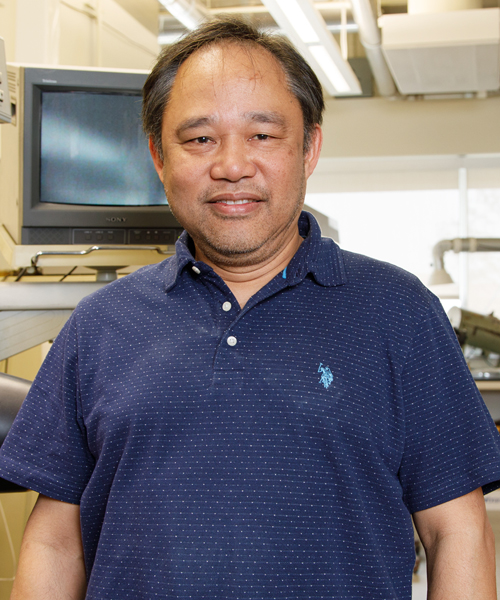TcSUH EventS
Special Seminar
Bond Bending Enhanced Ferroelectricity in Multiferroic Materials
by: Prof. C. D. Hu
Date: Monday May 21, 2007
Time: 4:00 pm – 5:00 pm
Location: Houston Science Center – Building 593 — Room 102
Overview
We studied transition metal oxides with spiral spin distribution. The bond bending at oxygen sites enables the hybridization of the t¬2g orbitalsof transition elements and the p-orbitals of oxygen atoms. Bloch functions are coupled due to the spiral spin distribution. The resulting wave functiongives rise to electronic distribution which has net electric polarization if spin-orbit interaction is considered.
Back to TcSUH News & Events
Conferences and Workshops
The International Conference on Strongly Correlated Electron Systems
by: TcSUH Administration
Date: Sunday May 13, 2007
Time: 12:00 am – 12:00 am
Location: Houston Science Center – Building 593 — Room 102
Overview
SCES'07 will cover a wide range of topics in the diverse area of strongly correlated systems. The correlated electronic and magnetic materials to be featured include f-electron based heavy fermion intermetallics, d-electron based transition metal compounds, and organic solids. Nanoscale structures and ultracold atoms in optical lattices, which have emerged as model systems to study correlation physics, will also be addressed. The conference will seek to deepen our understanding of the rich physical phenomena that arise from correlation effects. The anticipated focus will be on quantum phase transitions, non-Fermi liquid phenomena, quantum magnetism, unconventional superconductivity, and metal-insulator transitions. Both experimental and theoretical work will be highlighted. Mathematical models and computational studies will also be covered.
The conference will provide a forum to present new research and exchange new ideas. It will also facilitate cross fertilization among the different subjects, and introduce these subjects to junior researchers. Presentations will consist of plenary, invited and contributed talks/symposia complemented by busy poster sessions.
SCES'07 will add Houston to the long list of cities that welcomed the conference series: Sendai ('92), San Diego ('93), Amsterdam ('94), Goa ('95), Zürich ('96), Paris ('98), Nagano ('99), Ann Arbor ('01), Krakow ('02), Karlsruhe ('04), and Vienna ('05). Every three years since 1997, SCES has been joining the triennial International Conference on Magnetism, held in: Cairns ('97), Recife ('00), Rome ('03), and Kyoto ('06).
For more information, please visit the SCES'07 website.
Back to TcSUH News & Events
TcSUH Annual Student Research Symposium
33rdSemiannual TCSUH Student Symposium and BBQ Picnic
by: TcSUH Administration
Date: Tuesday May 01, 2007
Time: 1:00 pm – 5:00 pm
Location: Houston Science Center – Building 593 — Room 102
Overview
All members of TCSUH are invited to attend the 33rd Semiannual TcSUH Student Symposium. Students will present original research results to TcSUH members, guests and a panel of judges.
The Symposium will begin at 1:00 p.m. with a brief review of TcSUH’s progress. The afternoon will then continue with a series of 15-minute presentations representing novel work by undergraduate and graduate students from each of TcSUH’s laboratories. A Symposium Program, including the schedule and abstracts for each presentation, will be provided at the door.
BBQ, soft drinks and beer will be provided at the picnic following the symposium. Prize winners will be announced at the picnic.
Picnic RSVP: by Monday, April 24, 2007 at the TcSUH Office of Public Affairs, x38210
Back to TcSUH News & Events

Bi-Weekly Seminar
Some New Insights on the Chemistry of Intermetallics and Metal-Rich Phases
Date: Friday April 13, 2007
Time: 12:00 pm – 1:00 pm
Location: Houston Science Center – Building 593 — Room 102
Overview
Polar intermetallic phases formed between transition and post-transition metals with one or more of the electropositive alkali, alkaline-earth, and rare-earth metals exhibit a rich variety of complex structures. More importantly, the smooth transition of electronic properties from semiconducting intermetallics to classical metallic compounds along the Zintl border provides a fertile area to search for materials with novel electronic properties. This also offers unique opportunities in investigating structure-bonding-property relationships among materials at the border between metals and nonmetals. We have used the Zintl concept in rationalizing the synthesis, stoichiometry, and chemical bonding of novel ternary and quaternary “electron-poor†Zintl phases that exhibit unusual π-bonding. Recently, our exploratory work near the Zintl border has also resulted in a number of novel polar intermetallic structures. These compounds and other newly discovered polar intermetallics add new insight to the structural and chemical bonding peculiarities of Zintl phases and the less polar intermetallics. In addition, results of exploratory forays into the yet unexplored chemical reactivity of Zintl phases will be presented. The mild reduction and oxidation of the “salt-like” intermetallics provides a novel route to new materials with interesting properties and structures.
Back to TcSUH News & Events

Special Seminar
The 1-D BOSE GAS
by: Prof. Norm Frankel
Date: Wednesday April 11, 2007
Time: 11:00 am – 12:00 pm
Location: Houston Science Center – Building 593 — Room 102
Overview
The one dimensional delta function Bose gas is a classic system in the quantum many body problem. It has excited much study, with seminal contributions from theoretical physics and mathematics, over the past five decades.
The wonderful advent of exceedingly low temperature cyrogenics has brought the Bose gas into prominence. Very recently, with the application of sophisticated anisotropic traps, the Bose gas can be fashioned into a genuinely 1-D configuration, thus bringing this 1-D Bose gas into the special spotlight experimentally.
In the light of our recent works, we will focus on the density matrix and concomitantly the occupation numbers [distribution function] along with the pair correlation function and concomitantly the structure factor. These are the signature quantities of the Bose gas.
Back to TcSUH News & Events
